Pictures
IfA Hale-Bopp page
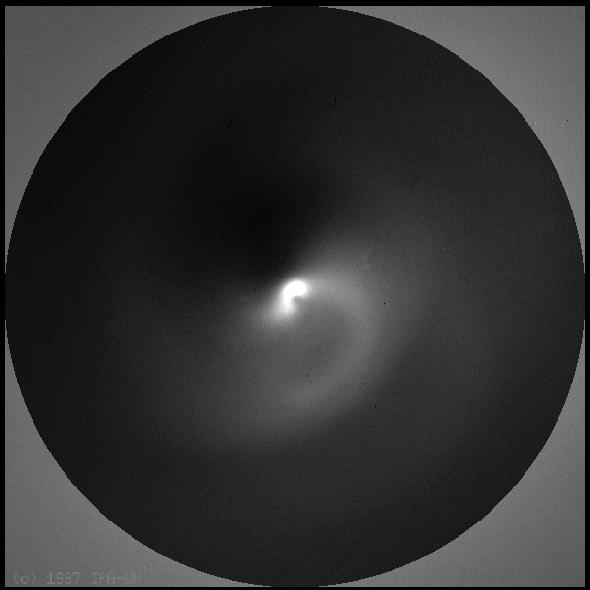 This 10sec exposure of comet Hale-Bopp was obtained by Bill Vacca
using the 2.2m telescope of the University of Hawaii telescope at
Mauna Kea, through a filter centered on the emission line of the CN
molecule, in the near Ultra-Violet.
The field of view of this image is 1.5 arcminute in diameter, 1/20th
of the apparent diameter of the moon; it shows only a very small
section of the comet which extends on many degrees (North is up, and
East is to the left). The image has been processed to correct the
sensitivity variations of the CCD detector (this steps are described
in another document), then has been enhanced to make the jet structure
more visible (a mean radial profile has been partially
subtracted). The seeing (degradation of the image quality by the
turbulence) was quite high.
This 10sec exposure of comet Hale-Bopp was obtained by Bill Vacca
using the 2.2m telescope of the University of Hawaii telescope at
Mauna Kea, through a filter centered on the emission line of the CN
molecule, in the near Ultra-Violet.
The field of view of this image is 1.5 arcminute in diameter, 1/20th
of the apparent diameter of the moon; it shows only a very small
section of the comet which extends on many degrees (North is up, and
East is to the left). The image has been processed to correct the
sensitivity variations of the CCD detector (this steps are described
in another document), then has been enhanced to make the jet structure
more visible (a mean radial profile has been partially
subtracted). The seeing (degradation of the image quality by the
turbulence) was quite high.
Hale-Bopp for the non-astronomer. Hale-Bopp ephemeris.
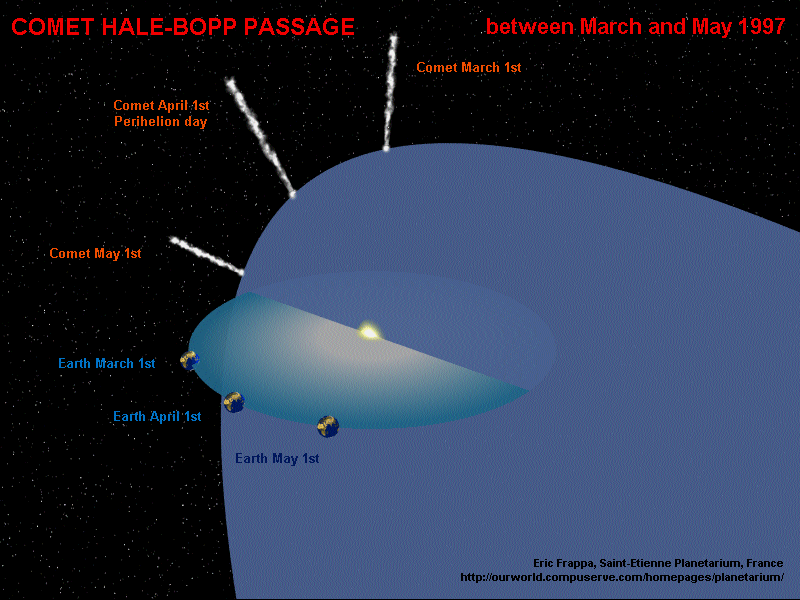 The orbit of this comet is of long period (~4200 years since the last
appearance and because of gravitational tugs by the planets,
particularly Jupiter, the next appearance will be in about 2380
years). It has been through the inner solar system before. That is, it
is not a new comet from the Oort Cloud. Its orbit is a very long,
stretched out ellipse and the comet is part of our solar system in
orbit around our Sun.
The comet reaches its closest point to the Sun (perihelion) on April
1, 1997. At that time, it will be about 0.914 astronomical units from
the Sun (one AU = about 93 million miles or 150 million kilometers --
the distance between the Sun and the Earth) or roughly 85 million
miles (138 million kilometers) from the Sun. This is not a
particularly close approach to the Sun. Some comets, like Comet
Ikeya-Seki in 1965, have literally skimmed the surface of the Sun (and
others have actually gone right into the Sun). Nonetheless, any comet
that comes within 1 AU of the Sun has a chance to put on a nice show.
It has been suggested by some people that this comet may pose a threat
to the Earth...
This comet will NOT hit the Earth.
The comet will make its closest approach to the Earth on March 23,
1997. At that time, the comet will be more than 120 million miles (194
million kilometers) from Earth -- not even a very close approach! Will
the comet "cross" the Earth's orbit? Well, yes and no...the comet
will come closer to the Sun than the Earth, but it will never actually
physically cross any point in space that is occupied by the Earth --
it can't hit the Earth!
The orbit is inclined nearly 90 degrees from the ecliptic (the plane
of our solar system in which the planets orbit). The comet will come
up from the south, go over the top of the Sun and then plunge down
again. This means that the comet will be best seen from the Southern
Hemisphere (and lower Northern latitudes) EXCEPT when it is expected
to be at its brightest. In March and April 1997, it will only be
easily visible from the Northern Hemisphere.
The orbit of this comet is of long period (~4200 years since the last
appearance and because of gravitational tugs by the planets,
particularly Jupiter, the next appearance will be in about 2380
years). It has been through the inner solar system before. That is, it
is not a new comet from the Oort Cloud. Its orbit is a very long,
stretched out ellipse and the comet is part of our solar system in
orbit around our Sun.
The comet reaches its closest point to the Sun (perihelion) on April
1, 1997. At that time, it will be about 0.914 astronomical units from
the Sun (one AU = about 93 million miles or 150 million kilometers --
the distance between the Sun and the Earth) or roughly 85 million
miles (138 million kilometers) from the Sun. This is not a
particularly close approach to the Sun. Some comets, like Comet
Ikeya-Seki in 1965, have literally skimmed the surface of the Sun (and
others have actually gone right into the Sun). Nonetheless, any comet
that comes within 1 AU of the Sun has a chance to put on a nice show.
It has been suggested by some people that this comet may pose a threat
to the Earth...
This comet will NOT hit the Earth.
The comet will make its closest approach to the Earth on March 23,
1997. At that time, the comet will be more than 120 million miles (194
million kilometers) from Earth -- not even a very close approach! Will
the comet "cross" the Earth's orbit? Well, yes and no...the comet
will come closer to the Sun than the Earth, but it will never actually
physically cross any point in space that is occupied by the Earth --
it can't hit the Earth!
The orbit is inclined nearly 90 degrees from the ecliptic (the plane
of our solar system in which the planets orbit). The comet will come
up from the south, go over the top of the Sun and then plunge down
again. This means that the comet will be best seen from the Southern
Hemisphere (and lower Northern latitudes) EXCEPT when it is expected
to be at its brightest. In March and April 1997, it will only be
easily visible from the Northern Hemisphere.
Hyakutake orbit
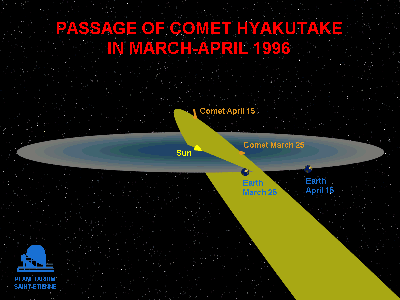
ESO Hale-Bopp
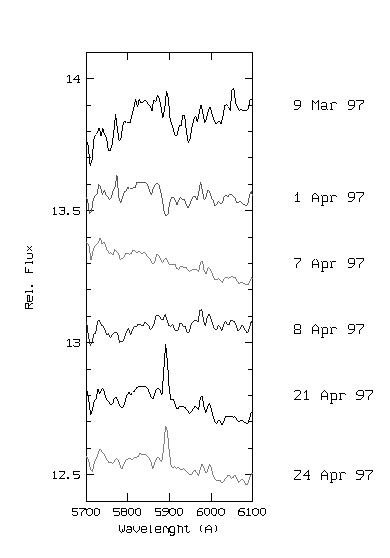 Of particular interest in these observations is the evolution of the
Sodium emission line observed in the core of the comet. The
corresponding spectral region is seen on these spectral tracings [GIF;
12k]. The line is clearly visible on top of the spectral continuum
(the reflected sunlight from the dust) in the last two runs (21 and 24
April), just after the discovery of the Na tail (cf. the 23 April
Update).
Note that this sodium doublet (in our spectra it is blended due to the
low resolving power) seems to appear already in the first spectrum
obtained on March 9, 1997. However, its presence in that spectrum may
be due to the background light of the close city of Freising or the
Munich Airport which were located at angular distances of about 60o
and 80o from the comet, respectively. Still, we believe that this is a
real emission line from the comet since the exposure times were
relatively short (around 80 sec). Unfortunately for this specific
observation we have no nearly simultaneous, recorded sky exposure to
confirm this assumption. On the following spectra, the Na line is not
present (1, 7 and 8 April, 1997).
Of particular interest in these observations is the evolution of the
Sodium emission line observed in the core of the comet. The
corresponding spectral region is seen on these spectral tracings [GIF;
12k]. The line is clearly visible on top of the spectral continuum
(the reflected sunlight from the dust) in the last two runs (21 and 24
April), just after the discovery of the Na tail (cf. the 23 April
Update).
Note that this sodium doublet (in our spectra it is blended due to the
low resolving power) seems to appear already in the first spectrum
obtained on March 9, 1997. However, its presence in that spectrum may
be due to the background light of the close city of Freising or the
Munich Airport which were located at angular distances of about 60o
and 80o from the comet, respectively. Still, we believe that this is a
real emission line from the comet since the exposure times were
relatively short (around 80 sec). Unfortunately for this specific
observation we have no nearly simultaneous, recorded sky exposure to
confirm this assumption. On the following spectra, the Na line is not
present (1, 7 and 8 April, 1997).
Kepler's Laws (Honolulu Comminity College)
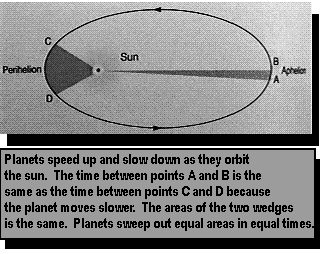 Planets have elliptical orbits with the sun at one focus
orbits are not circles
Aristotle's cosmology required circular orbits
sun is not the center
Equal areas swept in equal times
orbits are not at constant speed
Aristotle's cosmology required constant speed
Period squared is proportional to distance cubed
called The Harmonic Law
period is the time required for one orbit
distance refers to the average distance from the sun
planets further from the sun move slower
Aristotle's cosmology required all planets to move at the same speed
the relationship (harmonic ratio) is the same for earth and planets, except the
moon table shows relationships
Planets have elliptical orbits with the sun at one focus
orbits are not circles
Aristotle's cosmology required circular orbits
sun is not the center
Equal areas swept in equal times
orbits are not at constant speed
Aristotle's cosmology required constant speed
Period squared is proportional to distance cubed
called The Harmonic Law
period is the time required for one orbit
distance refers to the average distance from the sun
planets further from the sun move slower
Aristotle's cosmology required all planets to move at the same speed
the relationship (harmonic ratio) is the same for earth and planets, except the
moon table shows relationships
Pictures of the two comets
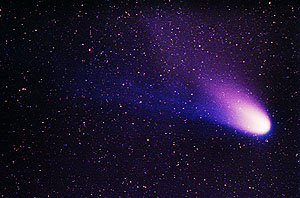
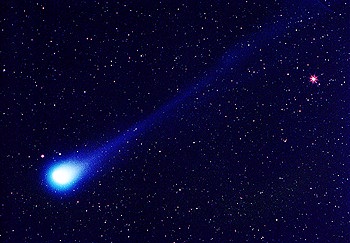 These photos were taken by John Chumack of Galactic Images
These photos were taken by John Chumack of Galactic Images
Hyakutake tail
 That's about where the similarity ends. Hale-Bopp is a dusty comet,
Hyakutake was dust-poor. The nucleus of Hale-Bopp is thought to be
huge, about 20-30 kilometers in diameter, while Hyakutake's is small,
only about 1-2 kilometers across. Hale-Bopp was discovered a
year-and-a-half before closest approach, and has been in our skies for
months; Hyakutake appeared virtually "out of nowhere", and the show
was over almost before we had time to react. Hale-Bopp must have
appeared in our skies 2500 years ago, while Hyakutake last showed up
(if at all!) over 50,000 years in the past.
So, why did Hyakutake put on such a great show, when it is merely
"peanuts" compared to the current comet? For one thing, Hyakutake came
nearly four times closer to the Sun than will Hale-Bopp - 0.23 AU
compared with 0.91 AU. For another, we got to see Hyakutake broadside,
while Hale-Bopp will be viewed from, at most, an aspect angle of 45
degrees. But most important of all, Hyakutake came close to us - very
close - missing the Earth by a mere 0.1 AU - while Hale-Bopp will, at
best, be over 9 times further away. So even though it wasn't a "great"
comet in its own right, it sure appeared that way to us!
What this all means is that Hale-Bopp won't produce nearly as long of
a tail as Hyakutake - which produced a 52 degree-long tail as seen by
this observer, with some reports of 70 degrees or longer. Hale-Bopp's
tail will probably appear more like 10 degrees long - 20 degrees at
most. On the other hand, we expect Hale-Bopp to be bright since it
should spew out lots of "stuff" into a smaller region (from our
vantage point) of the sky. So even though the total overall brightness
may be roughly the same, it should be more concentrated, and hence
easier to spot, with Hale-Bopp.
That's about where the similarity ends. Hale-Bopp is a dusty comet,
Hyakutake was dust-poor. The nucleus of Hale-Bopp is thought to be
huge, about 20-30 kilometers in diameter, while Hyakutake's is small,
only about 1-2 kilometers across. Hale-Bopp was discovered a
year-and-a-half before closest approach, and has been in our skies for
months; Hyakutake appeared virtually "out of nowhere", and the show
was over almost before we had time to react. Hale-Bopp must have
appeared in our skies 2500 years ago, while Hyakutake last showed up
(if at all!) over 50,000 years in the past.
So, why did Hyakutake put on such a great show, when it is merely
"peanuts" compared to the current comet? For one thing, Hyakutake came
nearly four times closer to the Sun than will Hale-Bopp - 0.23 AU
compared with 0.91 AU. For another, we got to see Hyakutake broadside,
while Hale-Bopp will be viewed from, at most, an aspect angle of 45
degrees. But most important of all, Hyakutake came close to us - very
close - missing the Earth by a mere 0.1 AU - while Hale-Bopp will, at
best, be over 9 times further away. So even though it wasn't a "great"
comet in its own right, it sure appeared that way to us!
What this all means is that Hale-Bopp won't produce nearly as long of
a tail as Hyakutake - which produced a 52 degree-long tail as seen by
this observer, with some reports of 70 degrees or longer. Hale-Bopp's
tail will probably appear more like 10 degrees long - 20 degrees at
most. On the other hand, we expect Hale-Bopp to be bright since it
should spew out lots of "stuff" into a smaller region (from our
vantage point) of the sky. So even though the total overall brightness
may be roughly the same, it should be more concentrated, and hence
easier to spot, with Hale-Bopp.
Sodium tail
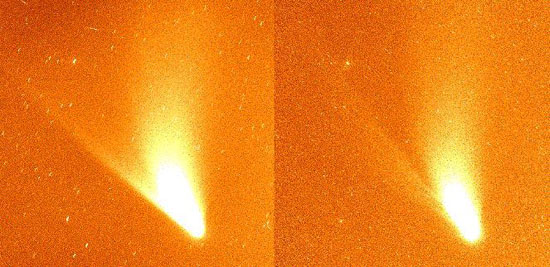 The picture on the left is the discovery image of the sodium
tail in Comet Hale-Bopp taken on the 16th April 1997. The
tail appears as a very straight narrow feature extending from
the head of the comet to the upper left. The picture on the
right is an image of Comet Hale-Bopp showing the ion and
dust tails of the comet, taken a few minutes before the
discovery of the sodium tail. The dust tail is the broad tail
pointing straight upwards, while the ion tail is the filamentary
structure to the left. Comparison of the two images shows
how the sodium tail has a completely different appearance to
the other tails of the comet.
The picture on the left is the discovery image of the sodium
tail in Comet Hale-Bopp taken on the 16th April 1997. The
tail appears as a very straight narrow feature extending from
the head of the comet to the upper left. The picture on the
right is an image of Comet Hale-Bopp showing the ion and
dust tails of the comet, taken a few minutes before the
discovery of the sodium tail. The dust tail is the broad tail
pointing straight upwards, while the ion tail is the filamentary
structure to the left. Comparison of the two images shows
how the sodium tail has a completely different appearance to
the other tails of the comet.
Astronomical Society of the Pacific
 Stars with trains of fire. For King Harold and the
Saxons, the appearance of a comet in 1066 was a
portent of doom; for Duke William and the
Normans, the same comet was a blessing from
heaven. Later that year, William's army defeated
Harold's forces at the Battle of Hastings. William's
wife, Queen Matilda, commissioned this tapestry,
the famous Bayeux Tapestry, to commemorate her
husband's victory. Today we know that the comet
was Halley's comet on one of its recurring visits.
Stars with trains of fire. For King Harold and the
Saxons, the appearance of a comet in 1066 was a
portent of doom; for Duke William and the
Normans, the same comet was a blessing from
heaven. Later that year, William's army defeated
Harold's forces at the Battle of Hastings. William's
wife, Queen Matilda, commissioned this tapestry,
the famous Bayeux Tapestry, to commemorate her
husband's victory. Today we know that the comet
was Halley's comet on one of its recurring visits.
Callisto crater chains
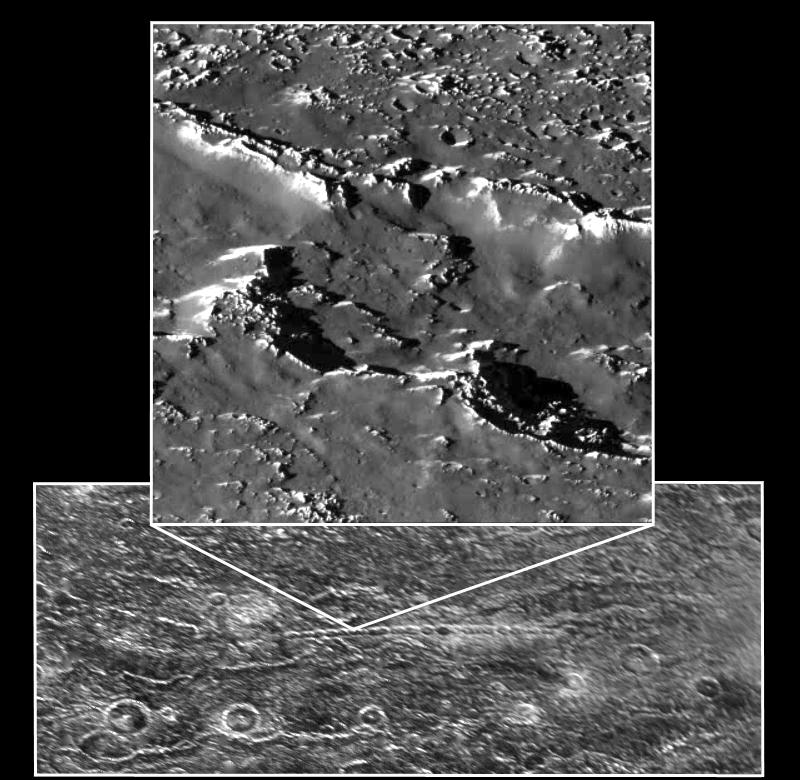 A portion of a chain of impact craters on Jupiter's moon Callisto is
seen in this image taken by the Galileo spacecraft on November 4,
1996. This crater chain on Callisto is believed to result from the
impact of a split object, similar to the fragments of Comet Shoemaker-
Levy 9 which smashed into Jupiter's atmosphere in July of 1994. This
high- resolution view, taken by Galileo's solid state imaging
television camera during its third orbit around Jupiter, is of
Callisto's northern hemisphere at 35 degrees north, 46 degrees west,
and covers an area of about eight miles (13 kilometers) across. The
smallest visible crater is about 140 yards (130 meters) across. The
image was taken at a range of 974 miles (1,567 kilometers).
A portion of a chain of impact craters on Jupiter's moon Callisto is
seen in this image taken by the Galileo spacecraft on November 4,
1996. This crater chain on Callisto is believed to result from the
impact of a split object, similar to the fragments of Comet Shoemaker-
Levy 9 which smashed into Jupiter's atmosphere in July of 1994. This
high- resolution view, taken by Galileo's solid state imaging
television camera during its third orbit around Jupiter, is of
Callisto's northern hemisphere at 35 degrees north, 46 degrees west,
and covers an area of about eight miles (13 kilometers) across. The
smallest visible crater is about 140 yards (130 meters) across. The
image was taken at a range of 974 miles (1,567 kilometers).
Oort cloud
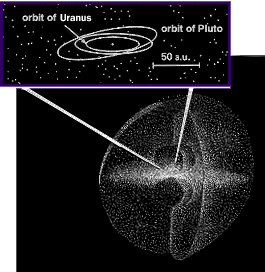
"Comets are like cats. They have tails and they do precisely what they want."
David Levy
Comet cartoon
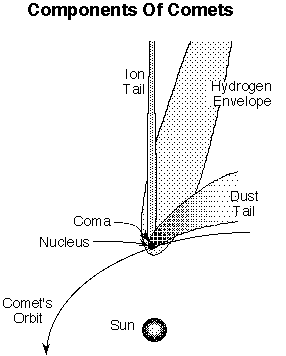
metshow
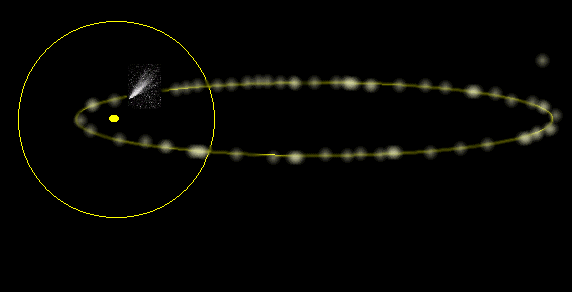
small comets
NASA's Polar Spacecraft Confirms ...
Small Comets are Pelting Earth
Part 1
A series of spectacular images produced by state-of-the-art cameras on
NASA's Polar spacecraft have confirmed that Earth is being pelted by
thousands of small comets each day. These never-before-seen images
establish the physical reality of the house-sized "snowballs" that
weigh tens of tons, break up as they approach Earth, and deposit large
clouds of water vapor in the upper atmosphere.
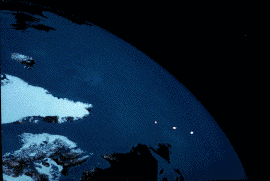 This image, for example, which was taken on Dec. 31, 1996 by the
Low-Resolution Visible Camera aboard the Polar spacecraft, is composed
of three consecutive snapshots of a cometary water cloud taken about
six seconds a part.
These Earthbound comets, however, represent no threat to either people
on the ground or in orbit as these objects disintegrate far above the
Earth's atmosphere. "In fact," says Louis A. Frank, the University of
Iowa space physicist who first proposed the existence of these small
comets more than a decade ago, "this relatively gentle cosmic rain and
its possible simple organic compounds may well have nurtured the
development of life on our planet."
In the Polar images the atmospheric holes appear as clusters of
pixels, or picture elements, rather than as single pixels as in the
Dynamics Explorer images, which had much less spatial resolution. The
atmospheric holes are measured to be 25-to-50 miles across. The Earth
camera on Polar detects these atmospheric holes at a rate that
suggests Earth is being bombarded by 5-to-30 small comets per minute,
approximately the same frequency recorded by the Dynamics Explorer
imager.
This image, for example, which was taken on Dec. 31, 1996 by the
Low-Resolution Visible Camera aboard the Polar spacecraft, is composed
of three consecutive snapshots of a cometary water cloud taken about
six seconds a part.
These Earthbound comets, however, represent no threat to either people
on the ground or in orbit as these objects disintegrate far above the
Earth's atmosphere. "In fact," says Louis A. Frank, the University of
Iowa space physicist who first proposed the existence of these small
comets more than a decade ago, "this relatively gentle cosmic rain and
its possible simple organic compounds may well have nurtured the
development of life on our planet."
In the Polar images the atmospheric holes appear as clusters of
pixels, or picture elements, rather than as single pixels as in the
Dynamics Explorer images, which had much less spatial resolution. The
atmospheric holes are measured to be 25-to-50 miles across. The Earth
camera on Polar detects these atmospheric holes at a rate that
suggests Earth is being bombarded by 5-to-30 small comets per minute,
approximately the same frequency recorded by the Dynamics Explorer
imager.
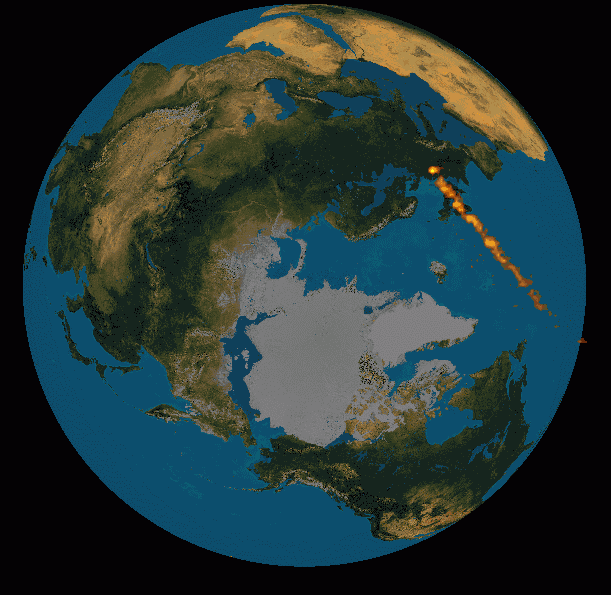 A spectacular disruption of a small comet the size of a two-bedroom
house took place 5,000 to 15,000 miles above the Atlantic Ocean at
2228 UT on September 26,1996. A view of Earth at the time of the event
has been superposed onto the far-ultraviolet image as a frame of
reference. This unusually bright and long-lived trail, which was
captured by the Earth Camera aboard NASA's Polar spacecraft, ends over
Germany. Images like this one show that there is a large population of
objects in Earth's vicinity that have not been previously detected.
A spectacular disruption of a small comet the size of a two-bedroom
house took place 5,000 to 15,000 miles above the Atlantic Ocean at
2228 UT on September 26,1996. A view of Earth at the time of the event
has been superposed onto the far-ultraviolet image as a frame of
reference. This unusually bright and long-lived trail, which was
captured by the Earth Camera aboard NASA's Polar spacecraft, ends over
Germany. Images like this one show that there is a large population of
objects in Earth's vicinity that have not been previously detected.
Chicxulub
 Fig.1. Surface geology, ring locations from gravity data, and wells
near the Chicxulub impact basin. The three wells that penetrated
impact melt rocks and breccias beneath the carbonate cover rocks are
C1 (Chicxulub 1), S1 (Sacapuc 1), and Y6 (Yucatan 6). Other well sites
shown are Yucatan 1 (Y1), Yucatan 2 (Y2), Yucatan 5A (Y5A), and Ticul
1 (T1). The Yucatan 4 (Y4) well site is located off the map, ~65 km
east of Y5A. Carbonate units at the surface are Q (Quaternary; <2 Ma),
Tu (Upper Tertiary; ~2–35 Ma), To (Oligocene; ~25–35 Ma),Te
(Eocene; ~35–55 Ma), and Tpal (Paleocene; ~55–65.0 Ma). The
crater center is indicated by ×. Hatchured lines represent the
Ticul fault system. Dashed lines indicate trend of ringlike zone of
water-filled sinkholes.
Fig.1. Surface geology, ring locations from gravity data, and wells
near the Chicxulub impact basin. The three wells that penetrated
impact melt rocks and breccias beneath the carbonate cover rocks are
C1 (Chicxulub 1), S1 (Sacapuc 1), and Y6 (Yucatan 6). Other well sites
shown are Yucatan 1 (Y1), Yucatan 2 (Y2), Yucatan 5A (Y5A), and Ticul
1 (T1). The Yucatan 4 (Y4) well site is located off the map, ~65 km
east of Y5A. Carbonate units at the surface are Q (Quaternary; <2 Ma),
Tu (Upper Tertiary; ~2–35 Ma), To (Oligocene; ~25–35 Ma),Te
(Eocene; ~35–55 Ma), and Tpal (Paleocene; ~55–65.0 Ma). The
crater center is indicated by ×. Hatchured lines represent the
Ticul fault system. Dashed lines indicate trend of ringlike zone of
water-filled sinkholes.
 This 10sec exposure of comet Hale-Bopp was obtained by Bill Vacca
using the 2.2m telescope of the University of Hawaii telescope at
Mauna Kea, through a filter centered on the emission line of the CN
molecule, in the near Ultra-Violet.
The field of view of this image is 1.5 arcminute in diameter, 1/20th
of the apparent diameter of the moon; it shows only a very small
section of the comet which extends on many degrees (North is up, and
East is to the left). The image has been processed to correct the
sensitivity variations of the CCD detector (this steps are described
in another document), then has been enhanced to make the jet structure
more visible (a mean radial profile has been partially
subtracted). The seeing (degradation of the image quality by the
turbulence) was quite high.
This 10sec exposure of comet Hale-Bopp was obtained by Bill Vacca
using the 2.2m telescope of the University of Hawaii telescope at
Mauna Kea, through a filter centered on the emission line of the CN
molecule, in the near Ultra-Violet.
The field of view of this image is 1.5 arcminute in diameter, 1/20th
of the apparent diameter of the moon; it shows only a very small
section of the comet which extends on many degrees (North is up, and
East is to the left). The image has been processed to correct the
sensitivity variations of the CCD detector (this steps are described
in another document), then has been enhanced to make the jet structure
more visible (a mean radial profile has been partially
subtracted). The seeing (degradation of the image quality by the
turbulence) was quite high.
 The orbit of this comet is of long period (~4200 years since the last
appearance and because of gravitational tugs by the planets,
particularly Jupiter, the next appearance will be in about 2380
years). It has been through the inner solar system before. That is, it
is not a new comet from the Oort Cloud. Its orbit is a very long,
stretched out ellipse and the comet is part of our solar system in
orbit around our Sun.
The comet reaches its closest point to the Sun (perihelion) on April
1, 1997. At that time, it will be about 0.914 astronomical units from
the Sun (one AU = about 93 million miles or 150 million kilometers --
the distance between the Sun and the Earth) or roughly 85 million
miles (138 million kilometers) from the Sun. This is not a
particularly close approach to the Sun. Some comets, like Comet
Ikeya-Seki in 1965, have literally skimmed the surface of the Sun (and
others have actually gone right into the Sun). Nonetheless, any comet
that comes within 1 AU of the Sun has a chance to put on a nice show.
It has been suggested by some people that this comet may pose a threat
to the Earth...
This comet will NOT hit the Earth.
The comet will make its closest approach to the Earth on March 23,
1997. At that time, the comet will be more than 120 million miles (194
million kilometers) from Earth -- not even a very close approach! Will
the comet "cross" the Earth's orbit? Well, yes and no...the comet
will come closer to the Sun than the Earth, but it will never actually
physically cross any point in space that is occupied by the Earth --
it can't hit the Earth!
The orbit is inclined nearly 90 degrees from the ecliptic (the plane
of our solar system in which the planets orbit). The comet will come
up from the south, go over the top of the Sun and then plunge down
again. This means that the comet will be best seen from the Southern
Hemisphere (and lower Northern latitudes) EXCEPT when it is expected
to be at its brightest. In March and April 1997, it will only be
easily visible from the Northern Hemisphere.
The orbit of this comet is of long period (~4200 years since the last
appearance and because of gravitational tugs by the planets,
particularly Jupiter, the next appearance will be in about 2380
years). It has been through the inner solar system before. That is, it
is not a new comet from the Oort Cloud. Its orbit is a very long,
stretched out ellipse and the comet is part of our solar system in
orbit around our Sun.
The comet reaches its closest point to the Sun (perihelion) on April
1, 1997. At that time, it will be about 0.914 astronomical units from
the Sun (one AU = about 93 million miles or 150 million kilometers --
the distance between the Sun and the Earth) or roughly 85 million
miles (138 million kilometers) from the Sun. This is not a
particularly close approach to the Sun. Some comets, like Comet
Ikeya-Seki in 1965, have literally skimmed the surface of the Sun (and
others have actually gone right into the Sun). Nonetheless, any comet
that comes within 1 AU of the Sun has a chance to put on a nice show.
It has been suggested by some people that this comet may pose a threat
to the Earth...
This comet will NOT hit the Earth.
The comet will make its closest approach to the Earth on March 23,
1997. At that time, the comet will be more than 120 million miles (194
million kilometers) from Earth -- not even a very close approach! Will
the comet "cross" the Earth's orbit? Well, yes and no...the comet
will come closer to the Sun than the Earth, but it will never actually
physically cross any point in space that is occupied by the Earth --
it can't hit the Earth!
The orbit is inclined nearly 90 degrees from the ecliptic (the plane
of our solar system in which the planets orbit). The comet will come
up from the south, go over the top of the Sun and then plunge down
again. This means that the comet will be best seen from the Southern
Hemisphere (and lower Northern latitudes) EXCEPT when it is expected
to be at its brightest. In March and April 1997, it will only be
easily visible from the Northern Hemisphere.

 Of particular interest in these observations is the evolution of the
Sodium emission line observed in the core of the comet. The
corresponding spectral region is seen on these spectral tracings [GIF;
12k]. The line is clearly visible on top of the spectral continuum
(the reflected sunlight from the dust) in the last two runs (21 and 24
April), just after the discovery of the Na tail (cf. the 23 April
Update).
Note that this sodium doublet (in our spectra it is blended due to the
low resolving power) seems to appear already in the first spectrum
obtained on March 9, 1997. However, its presence in that spectrum may
be due to the background light of the close city of Freising or the
Munich Airport which were located at angular distances of about 60o
and 80o from the comet, respectively. Still, we believe that this is a
real emission line from the comet since the exposure times were
relatively short (around 80 sec). Unfortunately for this specific
observation we have no nearly simultaneous, recorded sky exposure to
confirm this assumption. On the following spectra, the Na line is not
present (1, 7 and 8 April, 1997).
Of particular interest in these observations is the evolution of the
Sodium emission line observed in the core of the comet. The
corresponding spectral region is seen on these spectral tracings [GIF;
12k]. The line is clearly visible on top of the spectral continuum
(the reflected sunlight from the dust) in the last two runs (21 and 24
April), just after the discovery of the Na tail (cf. the 23 April
Update).
Note that this sodium doublet (in our spectra it is blended due to the
low resolving power) seems to appear already in the first spectrum
obtained on March 9, 1997. However, its presence in that spectrum may
be due to the background light of the close city of Freising or the
Munich Airport which were located at angular distances of about 60o
and 80o from the comet, respectively. Still, we believe that this is a
real emission line from the comet since the exposure times were
relatively short (around 80 sec). Unfortunately for this specific
observation we have no nearly simultaneous, recorded sky exposure to
confirm this assumption. On the following spectra, the Na line is not
present (1, 7 and 8 April, 1997).
 Planets have elliptical orbits with the sun at one focus
orbits are not circles
Aristotle's cosmology required circular orbits
sun is not the center
Equal areas swept in equal times
orbits are not at constant speed
Aristotle's cosmology required constant speed
Period squared is proportional to distance cubed
called The Harmonic Law
period is the time required for one orbit
distance refers to the average distance from the sun
planets further from the sun move slower
Aristotle's cosmology required all planets to move at the same speed
the relationship (harmonic ratio) is the same for earth and planets, except the
moon table shows relationships
Planets have elliptical orbits with the sun at one focus
orbits are not circles
Aristotle's cosmology required circular orbits
sun is not the center
Equal areas swept in equal times
orbits are not at constant speed
Aristotle's cosmology required constant speed
Period squared is proportional to distance cubed
called The Harmonic Law
period is the time required for one orbit
distance refers to the average distance from the sun
planets further from the sun move slower
Aristotle's cosmology required all planets to move at the same speed
the relationship (harmonic ratio) is the same for earth and planets, except the
moon table shows relationships

 These photos were taken by John Chumack of Galactic Images
These photos were taken by John Chumack of Galactic Images
 That's about where the similarity ends. Hale-Bopp is a dusty comet,
Hyakutake was dust-poor. The nucleus of Hale-Bopp is thought to be
huge, about 20-30 kilometers in diameter, while Hyakutake's is small,
only about 1-2 kilometers across. Hale-Bopp was discovered a
year-and-a-half before closest approach, and has been in our skies for
months; Hyakutake appeared virtually "out of nowhere", and the show
was over almost before we had time to react. Hale-Bopp must have
appeared in our skies 2500 years ago, while Hyakutake last showed up
(if at all!) over 50,000 years in the past.
So, why did Hyakutake put on such a great show, when it is merely
"peanuts" compared to the current comet? For one thing, Hyakutake came
nearly four times closer to the Sun than will Hale-Bopp - 0.23 AU
compared with 0.91 AU. For another, we got to see Hyakutake broadside,
while Hale-Bopp will be viewed from, at most, an aspect angle of 45
degrees. But most important of all, Hyakutake came close to us - very
close - missing the Earth by a mere 0.1 AU - while Hale-Bopp will, at
best, be over 9 times further away. So even though it wasn't a "great"
comet in its own right, it sure appeared that way to us!
What this all means is that Hale-Bopp won't produce nearly as long of
a tail as Hyakutake - which produced a 52 degree-long tail as seen by
this observer, with some reports of 70 degrees or longer. Hale-Bopp's
tail will probably appear more like 10 degrees long - 20 degrees at
most. On the other hand, we expect Hale-Bopp to be bright since it
should spew out lots of "stuff" into a smaller region (from our
vantage point) of the sky. So even though the total overall brightness
may be roughly the same, it should be more concentrated, and hence
easier to spot, with Hale-Bopp.
That's about where the similarity ends. Hale-Bopp is a dusty comet,
Hyakutake was dust-poor. The nucleus of Hale-Bopp is thought to be
huge, about 20-30 kilometers in diameter, while Hyakutake's is small,
only about 1-2 kilometers across. Hale-Bopp was discovered a
year-and-a-half before closest approach, and has been in our skies for
months; Hyakutake appeared virtually "out of nowhere", and the show
was over almost before we had time to react. Hale-Bopp must have
appeared in our skies 2500 years ago, while Hyakutake last showed up
(if at all!) over 50,000 years in the past.
So, why did Hyakutake put on such a great show, when it is merely
"peanuts" compared to the current comet? For one thing, Hyakutake came
nearly four times closer to the Sun than will Hale-Bopp - 0.23 AU
compared with 0.91 AU. For another, we got to see Hyakutake broadside,
while Hale-Bopp will be viewed from, at most, an aspect angle of 45
degrees. But most important of all, Hyakutake came close to us - very
close - missing the Earth by a mere 0.1 AU - while Hale-Bopp will, at
best, be over 9 times further away. So even though it wasn't a "great"
comet in its own right, it sure appeared that way to us!
What this all means is that Hale-Bopp won't produce nearly as long of
a tail as Hyakutake - which produced a 52 degree-long tail as seen by
this observer, with some reports of 70 degrees or longer. Hale-Bopp's
tail will probably appear more like 10 degrees long - 20 degrees at
most. On the other hand, we expect Hale-Bopp to be bright since it
should spew out lots of "stuff" into a smaller region (from our
vantage point) of the sky. So even though the total overall brightness
may be roughly the same, it should be more concentrated, and hence
easier to spot, with Hale-Bopp.
 The picture on the left is the discovery image of the sodium
tail in Comet Hale-Bopp taken on the 16th April 1997. The
tail appears as a very straight narrow feature extending from
the head of the comet to the upper left. The picture on the
right is an image of Comet Hale-Bopp showing the ion and
dust tails of the comet, taken a few minutes before the
discovery of the sodium tail. The dust tail is the broad tail
pointing straight upwards, while the ion tail is the filamentary
structure to the left. Comparison of the two images shows
how the sodium tail has a completely different appearance to
the other tails of the comet.
The picture on the left is the discovery image of the sodium
tail in Comet Hale-Bopp taken on the 16th April 1997. The
tail appears as a very straight narrow feature extending from
the head of the comet to the upper left. The picture on the
right is an image of Comet Hale-Bopp showing the ion and
dust tails of the comet, taken a few minutes before the
discovery of the sodium tail. The dust tail is the broad tail
pointing straight upwards, while the ion tail is the filamentary
structure to the left. Comparison of the two images shows
how the sodium tail has a completely different appearance to
the other tails of the comet.
 Stars with trains of fire. For King Harold and the
Saxons, the appearance of a comet in 1066 was a
portent of doom; for Duke William and the
Normans, the same comet was a blessing from
heaven. Later that year, William's army defeated
Harold's forces at the Battle of Hastings. William's
wife, Queen Matilda, commissioned this tapestry,
the famous Bayeux Tapestry, to commemorate her
husband's victory. Today we know that the comet
was Halley's comet on one of its recurring visits.
Stars with trains of fire. For King Harold and the
Saxons, the appearance of a comet in 1066 was a
portent of doom; for Duke William and the
Normans, the same comet was a blessing from
heaven. Later that year, William's army defeated
Harold's forces at the Battle of Hastings. William's
wife, Queen Matilda, commissioned this tapestry,
the famous Bayeux Tapestry, to commemorate her
husband's victory. Today we know that the comet
was Halley's comet on one of its recurring visits.
 A portion of a chain of impact craters on Jupiter's moon Callisto is
seen in this image taken by the Galileo spacecraft on November 4,
1996. This crater chain on Callisto is believed to result from the
impact of a split object, similar to the fragments of Comet Shoemaker-
Levy 9 which smashed into Jupiter's atmosphere in July of 1994. This
high- resolution view, taken by Galileo's solid state imaging
television camera during its third orbit around Jupiter, is of
Callisto's northern hemisphere at 35 degrees north, 46 degrees west,
and covers an area of about eight miles (13 kilometers) across. The
smallest visible crater is about 140 yards (130 meters) across. The
image was taken at a range of 974 miles (1,567 kilometers).
A portion of a chain of impact craters on Jupiter's moon Callisto is
seen in this image taken by the Galileo spacecraft on November 4,
1996. This crater chain on Callisto is believed to result from the
impact of a split object, similar to the fragments of Comet Shoemaker-
Levy 9 which smashed into Jupiter's atmosphere in July of 1994. This
high- resolution view, taken by Galileo's solid state imaging
television camera during its third orbit around Jupiter, is of
Callisto's northern hemisphere at 35 degrees north, 46 degrees west,
and covers an area of about eight miles (13 kilometers) across. The
smallest visible crater is about 140 yards (130 meters) across. The
image was taken at a range of 974 miles (1,567 kilometers).



 This image, for example, which was taken on Dec. 31, 1996 by the
Low-Resolution Visible Camera aboard the Polar spacecraft, is composed
of three consecutive snapshots of a cometary water cloud taken about
six seconds a part.
These Earthbound comets, however, represent no threat to either people
on the ground or in orbit as these objects disintegrate far above the
Earth's atmosphere. "In fact," says Louis A. Frank, the University of
Iowa space physicist who first proposed the existence of these small
comets more than a decade ago, "this relatively gentle cosmic rain and
its possible simple organic compounds may well have nurtured the
development of life on our planet."
In the Polar images the atmospheric holes appear as clusters of
pixels, or picture elements, rather than as single pixels as in the
Dynamics Explorer images, which had much less spatial resolution. The
atmospheric holes are measured to be 25-to-50 miles across. The Earth
camera on Polar detects these atmospheric holes at a rate that
suggests Earth is being bombarded by 5-to-30 small comets per minute,
approximately the same frequency recorded by the Dynamics Explorer
imager.
This image, for example, which was taken on Dec. 31, 1996 by the
Low-Resolution Visible Camera aboard the Polar spacecraft, is composed
of three consecutive snapshots of a cometary water cloud taken about
six seconds a part.
These Earthbound comets, however, represent no threat to either people
on the ground or in orbit as these objects disintegrate far above the
Earth's atmosphere. "In fact," says Louis A. Frank, the University of
Iowa space physicist who first proposed the existence of these small
comets more than a decade ago, "this relatively gentle cosmic rain and
its possible simple organic compounds may well have nurtured the
development of life on our planet."
In the Polar images the atmospheric holes appear as clusters of
pixels, or picture elements, rather than as single pixels as in the
Dynamics Explorer images, which had much less spatial resolution. The
atmospheric holes are measured to be 25-to-50 miles across. The Earth
camera on Polar detects these atmospheric holes at a rate that
suggests Earth is being bombarded by 5-to-30 small comets per minute,
approximately the same frequency recorded by the Dynamics Explorer
imager.
 A spectacular disruption of a small comet the size of a two-bedroom
house took place 5,000 to 15,000 miles above the Atlantic Ocean at
2228 UT on September 26,1996. A view of Earth at the time of the event
has been superposed onto the far-ultraviolet image as a frame of
reference. This unusually bright and long-lived trail, which was
captured by the Earth Camera aboard NASA's Polar spacecraft, ends over
Germany. Images like this one show that there is a large population of
objects in Earth's vicinity that have not been previously detected.
A spectacular disruption of a small comet the size of a two-bedroom
house took place 5,000 to 15,000 miles above the Atlantic Ocean at
2228 UT on September 26,1996. A view of Earth at the time of the event
has been superposed onto the far-ultraviolet image as a frame of
reference. This unusually bright and long-lived trail, which was
captured by the Earth Camera aboard NASA's Polar spacecraft, ends over
Germany. Images like this one show that there is a large population of
objects in Earth's vicinity that have not been previously detected.
 Fig.1. Surface geology, ring locations from gravity data, and wells
near the Chicxulub impact basin. The three wells that penetrated
impact melt rocks and breccias beneath the carbonate cover rocks are
C1 (Chicxulub 1), S1 (Sacapuc 1), and Y6 (Yucatan 6). Other well sites
shown are Yucatan 1 (Y1), Yucatan 2 (Y2), Yucatan 5A (Y5A), and Ticul
1 (T1). The Yucatan 4 (Y4) well site is located off the map, ~65 km
east of Y5A. Carbonate units at the surface are Q (Quaternary; <2 Ma),
Tu (Upper Tertiary; ~2–35 Ma), To (Oligocene; ~25–35 Ma),Te
(Eocene; ~35–55 Ma), and Tpal (Paleocene; ~55–65.0 Ma). The
crater center is indicated by ×. Hatchured lines represent the
Ticul fault system. Dashed lines indicate trend of ringlike zone of
water-filled sinkholes.
Fig.1. Surface geology, ring locations from gravity data, and wells
near the Chicxulub impact basin. The three wells that penetrated
impact melt rocks and breccias beneath the carbonate cover rocks are
C1 (Chicxulub 1), S1 (Sacapuc 1), and Y6 (Yucatan 6). Other well sites
shown are Yucatan 1 (Y1), Yucatan 2 (Y2), Yucatan 5A (Y5A), and Ticul
1 (T1). The Yucatan 4 (Y4) well site is located off the map, ~65 km
east of Y5A. Carbonate units at the surface are Q (Quaternary; <2 Ma),
Tu (Upper Tertiary; ~2–35 Ma), To (Oligocene; ~25–35 Ma),Te
(Eocene; ~35–55 Ma), and Tpal (Paleocene; ~55–65.0 Ma). The
crater center is indicated by ×. Hatchured lines represent the
Ticul fault system. Dashed lines indicate trend of ringlike zone of
water-filled sinkholes.